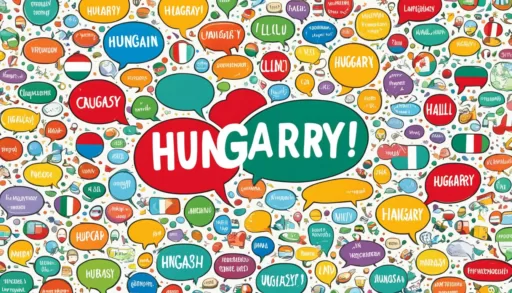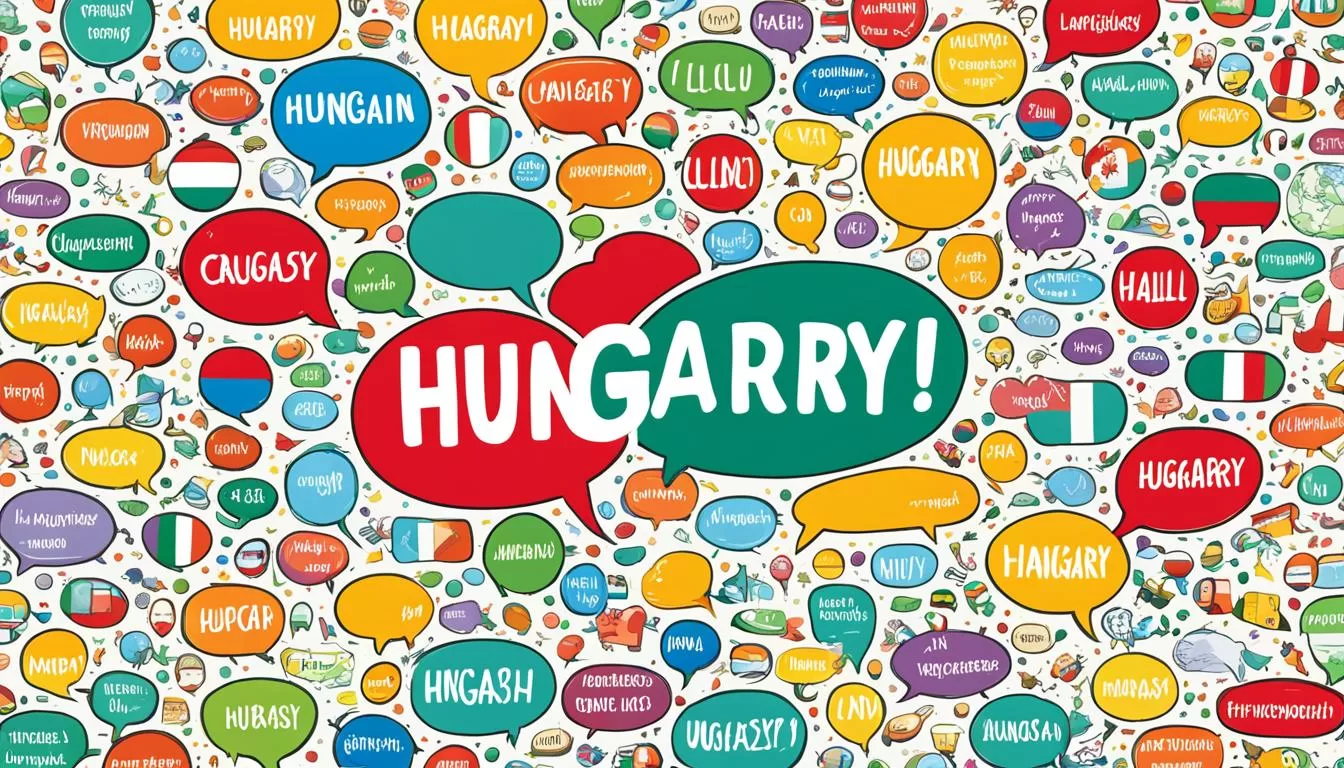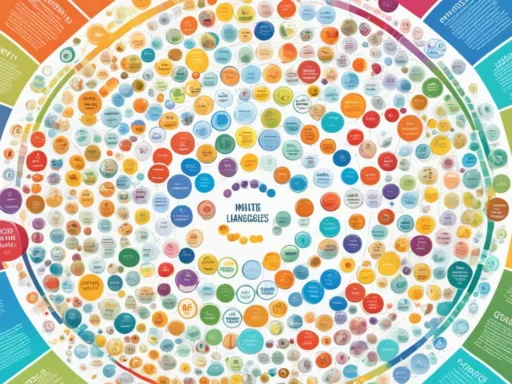As a crossroads of cultures and a nexus of numerous ethnicities, Hungary presents a fascinating study in language demographics. The country’s linguistic composition isn’t solely defined by the most spoken languages in Hungary but also by its rich patchwork of minority tongues and foreign dialects. At the heart of Hungary’s language mosaic is Hungarian, a language with deep Uralic roots, setting it apart from its Indo-European neighbors and acting as the nation’s official tongue. Beyond the borders of mainstream Hungarian usage, a collection of minority languages flourish, bolstered by policies aimed at cultural preservation. Among foreign languages, English and German have carved significant roles, proving essential in international communication and trade. This linguistic diversity engenders a unique identity that Hungary carries with pride—a testament to its historical legacy and contemporary global engagement.
With a compelling diversity of languages spoken in Hungary, understanding the language demographics becomes crucial, whether one is a language enthusiast, a cultural scholar, or a traveler planning to navigate the country’s charming streets. The array of voices—from the whimsical intonations of historical minority languages to the pragmatic vernaculars of global business—craft the auditory landscape that is as diverse as it is dynamic. Let us delve into the multilingual narratives that paint Hungary’s linguistic portrait.
Key Takeaways
- Hungarian is the official and most prevalently spoken language across Hungary’s demography.
- Language policies in Hungary aim to protect the cultural heritage of recognized minority languages.
- Foreign languages such as English and German play significant roles in the country’s international relations and commerce.
- Hungary’s linguistic landscape is enriched by the presence of a variety of minority languages, speaking to its complex cultural identity.
- Understanding the language demographics in Hungary is essential for immersive cultural experiences and effective communication.
- Language preservation efforts reflect Hungary’s commitment to embracing its diverse linguistic heritage.
Hungarian: The Official and Predominant Language of Hungary
The roots of the Hungarian language stretch deep, anchoring the nation’s linguistic identity to the unique Uralic family. As the official language of Hungary, Hungarian’s significance is more than just a communicative tool—it’s a symbol of cultural unity and a testament to the country’s history.
The Uralic Roots of Hungarian
Stepping away from the typical Indo-European linguistic norms of the region, Hungarian boasts a lineage that traces back to the ancient Uralic language family. This linguistic heritage not only enhances the diversity of the European linguistic landscape but also adds to the intrigue and complexity of learning the Hungarian language, offering an entirely different grammatical structure and vocabulary set to that of its neighbours.
Hungarian Language Dominance in Demographics
According to the meticulous records of census data, Hungarian powerfully dominates the country’s demographics as a mother tongue. To put numbers to this dominance, the 2011 census reported a staggering 9,896,333 people as Hungarian speakers—an overwhelming majority that stands as a clear indicator of the language’s prevalence within official languages Hungary.
Hungarian Language Use in Education and Government
No corner of Hungarian society is untouched by the pervasive use of its eponymous language. From the youngest minds absorbing lessons in classrooms to the halls of governance where policies are debated and drafted, Hungarian is the medium through which education is imparted and national dialogues are conducted, cementing its role as the foundation upon which the nation’s intellect and legislative framework are built.
| Aspect of Hungarian Society | Roles Played by Hungarian Language |
|---|---|
| Education | Primary medium of instruction across schools and higher education institutions |
| Government | Official language of legislation, administration, and judicial processes |
| Media | Preferred language for news outlets, literature, television, and radio |
| Cultural identity | A unifying thread linking the diverse communities of Hungary |
Amidst the mosaic of languages that span European tongues, the Hungarian language stands out with prideful distinction, carrying its rich historical legacy into the modern era and proving pivotal to the lives of Hungarians nationwide.
Endangered Linguistic Heritage: Minority Languages in Hungary
In the rich tapestry of Hungary’s cultural identity, the vibrancy of minority languages contributes to the fascinating narrative of language diversity Hungary. The Hungarian government has demonstrated its commitment to preserving this linguistic richness by adopting the European Charter for Regional or Minority Languages, which protects a multitude of languages such as Armenian, Boyash, and Serbian. Despite these efforts, the tide of linguistic assimilation threatens the continuity of these treasured dialects, marking them as endangered facets of Hungary’s heritage.
Concerns about the future of minority languages Hungary resonate among language advocates and cultural historians alike. In the face of globalization and cultural homogenization, how does Hungary maintain its linguistic pluralism? The language policy Hungary has pioneered includes not only legal frameworks but also educational and cultural initiatives designed to foster an environment in which minority languages can thrive.
Language is the roadmap of a culture. It tells you where its people come from and where they are going. – Rita Mae Brown
Hungary’s approach to safeguarding its linguistic minorities reflects a broader European movement to celebrate linguistic heterogeneity, not as an impediment but as a cultural cornerstone. The European Charter, in conjunction with Hungary’s own policies, creates spaces for these languages to be spoken, taught, and cherished. Hungary stands as a beacon for language preservation, setting a venerable example of cultural stewardship.

- Armenian: A language with roots in the ancient Silk Road, it now whispers the stories of its speakers in Hungary.
- Boyash: Once the vernacular of rovers, it now seeks a firm place in the educational and cultural landscape of Hungary.
- Serbian: Its lilting sounds reflect the interwoven history of neighbors, surviving as a testament to enduring connections.
| Language | Speakers in Hungary | Status |
|---|---|---|
| Armenian | Minority Community | Recognized and Protected |
| Boyash | Minority Community | Endangered and Supported |
| Serbian | Minority Community | Supported and Culturally Significant |
As each minority language narrates a unique chapter of Hungary’s historical saga, their place in the nation’s present and future relies on the concerted endeavors of policy, education, and community engagement. With the spirit of inclusion, the melody of language diversity Hungary shall continue to harmonize with the country’s societal symphony.
Languages Spoken Hungary: A Multicultural Mosaic
In the heart of Central Europe, Hungary’s rich cultural tapestry is exemplified by its extensive range of languages, showcasing a nation where multilingualism isn’t just a phenomenon—it’s a way of life. The Hungarian government’s commitment to sustaining this vibrancy manifests through a series of robust measures designed to support a multitude of linguistic minorities. These measures are underpinned by an overarching commitment to fostering an environment that respects and promotes language diversity—a core value rooted in Hungarian cultural ethos.

Government Initiatives for Language Preservation
The foundation of language preservation in Hungary is bolstered by legislative measures and policy initiatives. Principal among these is the Act on the Rights of National and Ethnic Minorities which underscores the nation’s dedication to safeguarding the linguistic liberties of its citizens. This comprehensive language policy Hungary embodies a spirit of inclusivity and protection for those minority languages that are an indivisible part of the Hungarian heritage.
The European Charter for Regional or Minority Languages and Its Impact
Ratification of the European Charter for Regional or Minority Languages has been a pivotal step for Hungary in its quest to uphold the tenets of linguistic diversity. By this act, Hungary has invested in the broader European framework that seeks not only to preserve but also to encourage the practice and development of languages such as Armenian, Bulgarian, and Croatian, ensuring that these languages are provided with the appropriate platforms for growth and cultural expression. This commitment further validates Hungary’s stance on multilingualism Hungary, offering a supportive infrastructure for linguistic minorities.
| Language | Community Supported | Initiatives in Place |
|---|---|---|
| German | German minorities in Hungary | Educational programs, Media in the German language |
| Slovak | Slovak communities in Northern Hungary | Cultural events, Slovak-Hungarian cross-border cooperation |
| Romanian | Romanian minorities, mainly in Eastern Hungary | Autonomy in education, Romanian language media |
| Croatian | Croatian communities in Southern Hungary | Language preservation projects, Croatian language courses |
The kaleidoscope of language in Hungary paints a picture not just of present-day lifestyle but also echoes the historical sequences that have shaped this nation. From governmental support to embracing European policies, Hungary indeed reflects the splendor of a multicultural mosaic, with every language contributing to the country’s unique sociocultural narrative.
The Role of German and Other Minority Languages Spoken by Ethnic Groups in Hungary
As the linguistic palette of Hungary is painted with various ethnic strokes, the languages spoken Hungary mirror its storied past and its vibrant cultural milieu. Each minority language that echoes through the valleys and cities of Hungary adds a rich hue to the country’s identity. One cannot overlook the resonating presence of the German language, especially in regions inhabited by the German minority, like the Mecsek Mountains. German’s robust cultural legacy within Hungary owes much to its recognition under the European Charter for Regional or Minority Languages.

These minority languages, along with German, grace Hungary’s sociolinguistic fabric. They transcend being mere modes of communication; they embody the traditions, memories, and the distinct ways of life of the ethnic groups they represent. Thus, when discussing the languages spoken Hungary, it is essential to recognize these communities not merely as linguistic representatives but as pivotal contributors to Hungary’s rich cultural tapestry.
Every language is like a world within. To speak a language is to take on a world, a culture. – Frantz Fanon
German in Hungary, primarily learned and preserved within ethnic communities, serves as a binding thread connecting Hungary to broader European historical narratives and current dynamics. Its prevalence among the German-speaking populace is instrumental in maintaining the integrity of their cultural expression and heritage.
In addition to German, other minority languages such as Slovak, Serbian, and Romanian resonate throughout their specific regions, further narrating the story of Hungary’s multicultural legacy. The influence of these minorities’ languages reaches beyond their communities, contributing to the educational, cultural, and sometimes even political spheres.
The following table illustrates the linguistic mosaic formed by German and other minority languages spoken by ethnic groups entrenched in Hungary’s societal fabric:
| Minority Language | Main Regions Spoken | Role in Cultural Heritage |
|---|---|---|
| German | Mecsek Mountains and beyond | Preservation of German minority traditions and connection to European history |
| Slovak | Northern Hungary | Enhancement of cross-border relations and cultural exchanges |
| Serbian | Regions in Southern Hungary | Sustenance of historical ties and Serbian community identity |
| Romanian | Areas around Gyula, Eastern Hungary | Cultural and educational autonomy for the Romanian minority |
As Hungary charts its course within the modern European setting, these enclaves of ethnic languages, particularly German in Hungary, provide a vital link to the shared cultural landscapes that span beyond the nation’s borders. They offer not only the nostalgic echoes of ancestral narrations but also an ongoing, evolving story of communities upholding and celebrating their diverse roots.
Ultimately, the minority languages of Hungary serve as vital witnesses and participants in the ever-unfolding narrative of the nation’s cultural evolution. By exploring this linguistic diversity, one gains a deeper appreciation of the intricate fabric that continues to shape Hungary’s identity.
Adopting Foreign Tongues: Influence of English and German
The globalized era has reshaped the language demographics Hungary experiences today, ushering in an age where multilingualism Hungary is not only celebrated but has become a competitive advantage. English and German, once foreign tongues, are now integral to Hungary’s linguistic identity, facilitating everything from international diplomacy to business expansion. The proficiency in these languages reflects Hungary’s commitment to strengthening its global outreach and economic capabilities.

English: From Classrooms to Corporate
English has permeated through the Hungarian education system to become a cornerstone of professional communication within the nation. An impressive 16% of Hungarians, as reported in the 2011 census, have embraced English. This widespread usage signals the language’s pivotal role from academic pursuits to corporate trades, underlining its importance in preparing Hungary’s youth for the demands of the international job market.
The Historical Links and Current Relevance of German in Hungary
German in Hungary wields significant influence owing to deep-rooted historical connections and contemporary ties, spoken by 11.2% of the population. It stands as a testament to the country’s past affiliations and current alignments, underpinning not just cultural exchanges but also economic ventures that benefit from Hungary’s strategic Central European location.
| Language | Role in Education | Role in Business | Speakers in Hungary (%) |
|---|---|---|---|
| English | Main foreign language in schools | Key to international business and trade | 16.0% |
| German | Widely taught, reflecting historical ties | Crucial in bilateral trade agreements | 11.2% |
The synergy of language demographics Hungary showcases—especially through the lenses of English and German—goes beyond mere communication. It reflects a nation ever-evolving, eagerly adopting foreign languages that amplify its voice on the global stage while honoring its multilingual heritage.
Breaking Language Barriers: Translation and Interpretation in Hungary
In the dynamic interplay of cultures present within Hungary, language barriers Hungary pose significant challenges for visitors and businesses alike. Despite the prevalence of English in global communication, its penetration in Hungary remains less extensive, necessitating robust translation services Hungary for adept cross-cultural interactions.

Technology, in its relentless march forward, has served as a bridge across these communication divides. Applications like Google Translate provide tourists and expatriates with a digital lifeline, assisting in real-time conversations and making sense of unfamiliar text. This digital sorcery works wonders for menu deciphering or navigating the cobbled streets with bilingual signage, yet it’s not without its flaws.
Technology provides you with tools, but the finesse of human understanding irons out the nuances.
For formal affairs—be it corporate contracts or governmental liaisons—the intricate accuracy and cultural nuance afforded by professional translation services Hungary are indispensable. To illustrate the vigour of professional translation, consider the case of visa applications, where precision isn’t just a luxury, it’s a quintessential requirement. No algorithm, however advanced, can finesse idiomatic expressions and cultural intricacies like a seasoned linguist.
The following table provides insight into the contrast between machine translation and professional services, underscoring the irreplaceable value of human expertise in scenarios where each word could hold the weight of understanding or misunderstanding:
| Translation Method | Recommended Use Cases | Considerations |
|---|---|---|
| Machine translation (e.g., Google Translate) | Navigating daily life as a tourist, basic conversations | Convenience, speed, prone to inaccuracies |
| Professional translation services | Official documents, legal proceedings, business negotiations | Accuracy, cultural knowledge, confidentiality |
In the quest to conquer linguistic hurdles, Hungary situates itself at an interesting juncture where the old world meets new technology. It’s in this confluence that translation services Hungary find their significance, demystifying language barriers and curating cross-cultural exchanges that resonate with clarity and authenticity.
Conclusion
As we encapsulate the intricate narrative of Hungary’s multilingual canvas, it becomes abundantly clear that the nation’s cultural vigour is significantly bolstered by its linguistic multiplicity. Hungary, in embracing its myriad of vernaculars, stands as a robust archetype of linguistic harmony, integrating this plurality into the bedrock of national pride and a forward-looking global persona. The nation’s policies mirror a determined stance to not only preserve but also to exalt the heritage intrinsic to every syllable of its minority languages. Language diversity Hungary is not merely a characteristic to be passively acknowledged, but a dynamic strength that is actively fostered and celebrated.
Embracing Language Diversity as Hungary’s Strength
Fostering language diversity Hungary has enabled a rich tapestry of linguistic expression to thrive within its borders. This commitment to language preservation extends beyond mere formality; it is a testament to Hungary’s tenacious spirit and its endeavor to maintain a vibrant cultural identity. By safeguarding minority dialects and promoting languages like English and German, Hungary has embraced the essence of its historical roots while adeptly navigating the waters of global interconnectedness.
Fostering Multilingualism for a Connected World
As globalization weaves nations ever closer together, fostering multilingualism Hungary remains a critical element in maintaining not just interpersonal connections, but the very essence of Hungary’s participation on the world stage. The presence of prevalent foreign languages amongst its citizenry equips Hungary with a versatile linguistic toolkit, enabling the country to effectively engage with international counterparts. In this way, Hungary demonstrates a balance uniquely its own—a celebration of linguistic diversity intertwining with a commitment to multilingual competency and global outreach.
FAQ
What languages are spoken in Hungary?
The most spoken language in Hungary is Hungarian, which is the official language. Minority languages such as Croatian, German, Serbian, Slovak, Romani, Romanian, and others are also spoken. English and German are the most prevalent foreign languages in Hungary.
Is Hungarian the only official language of Hungary?
Yes, Hungarian is the sole official language of Hungary. It belongs to the Uralic language family and is distinct from most other languages in Europe.
What are the Uralic roots of Hungarian?
Hungarian is part of the Finno-Ugric group within the Uralic language family, which also includes Finnish and Estonian. It is believed to have originated near the Ural Mountains and later spread to the Carpathian Basin.
How prevalent is the Hungarian language in demographics?
Hungarian is spoken by approximately 98.9% of the population as their first language. It dominates the linguistic landscape of Hungary.
How is the Hungarian language used in education and government?
Hungarian is extensively used in all levels of education as well as in government affairs. It is the primary medium of instruction in schools and the language used for all official documents and communications.
Which minority languages are endangered in Hungary?
Some minority languages in Hungary are considered endangered due to high levels of linguistic assimilation. These include languages like Hanty, Mansi, and Boyash, among others.
What government initiatives exist for language preservation in Hungary?
The Hungarian government has ratified the European Charter for Regional or Minority Languages and passed the Act on the Rights of National and Ethnic Minorities to support the preservation and promotion of minority languages and cultures.
How does the European Charter for Regional or Minority Languages impact Hungary?
The Charter commits Hungary to recognizing and protecting minority languages, offering these language speakers various rights and opportunities to use and develop their languages in private and public life.
What is the significance of the German language in Hungary?
The German minority of Hungary, particularly in the Mecsek Mountains region, speaks German. This language also has historical importance and is additionally recognized under the European Charter for Regional or Minority Languages.
How has English become influential in Hungary?
English is increasingly taught in schools and used in business and tourism in Hungary. It is spoken by around 40% of Hungarians and serves as an important language for international communication.
What are the historical links of German in Hungary?
Germany has had longstanding economic and cultural ties with Hungary. As a result, the German language has historical significance and continues to be relevant in business, education, and among the ethnic German community in Hungary.
How does Hungary handle translation and interpretation services?
Hungary offers professional translation and interpretation services for official matters, tourism, and business to facilitate communication between Hungarian speakers and non-speakers. Technology such as machine translation is also commonly used for more informal interactions.
Why is embracing language diversity Hungary’s strength?
Hungary’s commitment to preserving its linguistic heritage and recognizing minority languages contributes to its cultural richness. Embracing language diversity also enhances social cohesion and fosters an inclusive society.
How does fostering multilingualism benefit Hungary in a connected world?
Fostering multilingualism in Hungary allows for more effective participation in the global community, promotes international business and cultural exchanges, and helps to position Hungary as a nation that values both tradition and global interconnectedness.






